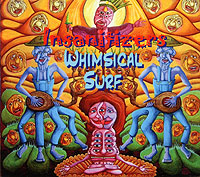 Released
in time for Summer 2010, The Insanitizers have a rave up on Whimsical
Surf. The 17 cut all instrumental CD is just the ticket to get
things moving in this summer heat. Interestingly, all the tracks were
written and/or arranged by Insanitizers guitarist Conrad Swartz,
who really cuts loose with a blockade of power chords and roaring
surf-rock licks while getting some rocking support from Tim Ennis
and Mike Martin (percussion) and Ralf Palin (bass).
In addition to a love of The Ventures and Dick Dale, Conrad and company
also like to surf out on vintage classical melodies from classicists
like Tchaikovsky, Rossini and Grieg while also sporting some interesting
influences like Alfred Hitchcock’s theme song! All done surf-style,
Whimsical Surf is pretty authentic from start to finish. The
CD sounds great and the band has done a super job packaging their
silver disc CD with excellent digi-pak graphics. Check The Insanitizers
out on CDBaby.com and Guitar9.com and Facebook!
Released
in time for Summer 2010, The Insanitizers have a rave up on Whimsical
Surf. The 17 cut all instrumental CD is just the ticket to get
things moving in this summer heat. Interestingly, all the tracks were
written and/or arranged by Insanitizers guitarist Conrad Swartz,
who really cuts loose with a blockade of power chords and roaring
surf-rock licks while getting some rocking support from Tim Ennis
and Mike Martin (percussion) and Ralf Palin (bass).
In addition to a love of The Ventures and Dick Dale, Conrad and company
also like to surf out on vintage classical melodies from classicists
like Tchaikovsky, Rossini and Grieg while also sporting some interesting
influences like Alfred Hitchcock’s theme song! All done surf-style,
Whimsical Surf is pretty authentic from start to finish. The
CD sounds great and the band has done a super job packaging their
silver disc CD with excellent digi-pak graphics. Check The Insanitizers
out on CDBaby.com and Guitar9.com and Facebook!
MUSIC WEB EXPRESS 3000
presents Guitars Center Stage
with CONRAD SWARTZ of The Insanitizers
Guitarists making waves in the music world,
their new recordings and gear!
Musical Background
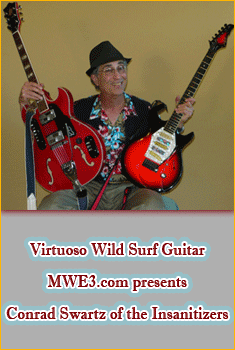 My
mom insisted on piano lessons when I was young. Playing our piano
was like running in sand. It had been a motorized player piano, but
the automation was removed. Striking notes took fingers of steel and
that’s what I developed. Later, in junior high typing class,
classmates would gather to watch me type a hundred words per minute
on our manual typewriters.
My
mom insisted on piano lessons when I was young. Playing our piano
was like running in sand. It had been a motorized player piano, but
the automation was removed. Striking notes took fingers of steel and
that’s what I developed. Later, in junior high typing class,
classmates would gather to watch me type a hundred words per minute
on our manual typewriters.
My first guitar came from a department store. It too needed steel
fingers. After plunking through “Alfred’s” book series
I took lessons from Sid Margolis, Arthur Godfrey’s guitarist.
My second guitar was a 4 pickup Zim-Gar with a Louisville Slugger
neck and chrome like a ‘60s Chevy. Friends and I put together
a band and played at the New York World’s Fair several times.
Fighting with these guitars remained a hobby as I pursued a Ph.D.,
an MD, and then a career as a med school prof. I listened to the Ventures
and the Shadows while toiling through manuscripts. In 1989, in a waiting
room, I read a hospital administration magazine feature about a doc
who enjoyed playing guitar like Yngwie. This led me to buy a good
guitar and develop my skills.
In 2000 I started recording on computer. This strongly improved my
skills. In 2002 I started recording with another doctor who plays
drums, Mike Martin. Then I would add bass and nearly always a track
or two of guitar or guitar synth. It became fun to develop original
songs this way. I found engineering the recordings to be as complex
as guitar playing, but my engineering background helped me learn.
New
CD
My plan
was for listening to be fun. For this I must have fun playing the
songs. So, most of the songs are uptempo, lively, vigorous, and energizing,
and the two slow songs are sardonic. This is why the CD is named “Whimsical
Surf.” There is no wondering when a vocalist will start, it is
immediately clear that the guitar is the focus. Recordings were made
in my home studio, now a huge room with a 16 foot ceiling. I recorded
15 songs with drummer Mike Martin on Roland V-drums; these give consistently
clear recordings of every drum and cymbal. I handled percussion on
“Waterboard Surfing” and “Dance Like A Robot.”
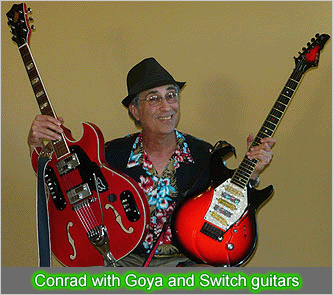
Guitar timbres vary widely among the songs on the CD, to suit the
mood of the pieces. Some guitar leads are squeaky clean and shimmering,
others use mild overdrive, and the bridge in “Head-Spin”
uses a sizzling smoky distortion. Five songs use an unusual multi-drive
effect. When two or more notes are played together the multi-drive
effect sounds brassy or woody, not thick or fuzzy. If I bend several
strings it sounds like a violin ensemble.
Five songs are based on classical music. The main theme of “Sugarplum”
is as Tchaikovsky wrote it—with the same sequence of diminished
chords—but the duet, surf style, intro, bridge, and ending are
original. The variations I wrote in “Mountain King” avoid
the repetitiousness in other versions I’ve heard. “Polkzart”
plays the theme of Mozart’s 40th Symphony as a polka. Gounod’s
“…Marionette” march, famous as the Hitchcock theme
song, accounts for most of the main theme in "Puppetor".
The other themes are impressionistic variations. This song was originally
scored for bassoon, and the multi-drive guitar sounds similar to it
here. With manically vigorous drums and bass, “Masked Man”
has galloping energy beyond Rossini’s symphonic scoring. This
is the piece I always wanted to play on the guitar; when I play it
I am “The Lone Ranger.”
Experiments with the vibrato arm led to “Froggy’s Magic
Twanger.” It has a series of riffs with almost continuous twangy
string bending or vibrato. Sometimes I floor the vibrato with my left
hand while picking with my right, all tunefully of course. Despite
Duane Eddy I’ve never heard another piece with this much rocking
twang. I love performing this because the eyes of the audience widen
into saucers.
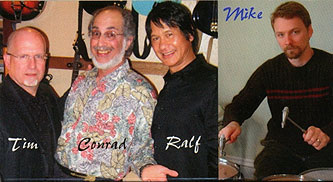
Another fun performance piece is “Surfin’ the Stars.”
It takes me all over the neck and has showy riffs that must be played
above the 12th fret on the lowest three strings. This is because open
strings are essential to the riff. I posted a video of a different
version of this piece on YouTube (under the name VentureShadow). I
also entered this video in the 2010 Guitar Player instrumental competition
and it ranked #6 in viewer ratings against all entries from classical
to heavy metal; another recording of mine ranked #4 (“Surf Wall
Street”; it’s not on this CD).
“Fantwango” was the most technically challenging piece.
I played it thousands of times before this recording. This piece is
unusual for combining finger picking with distortion. This is workable
only because the distortion is multi-drive type, so there is no interference
among multiple notes ringing at the same time. I posted a video of
performing an earlier clean version on YouTube (again as VentureShadow).
“Head-Spin” earned its name in several ways. I once worked
at St. Louis University, where the events associated with The Exorcist
occurred. The song gives the image of escape on a speeding motorcycle,
with heads spinning watching it go. It displays a dramatic contrast
between the brassy multi-drive distortion of the main theme and more
typical tube distortions, one sizzling and the other smoky.
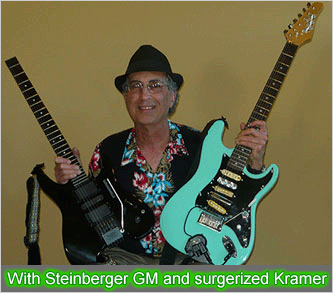 Another
song that uses guitar effects as sound effects is “Undertow.”
Applying a phaser effect to the guitar chord riff shuttling between
B and A chords and then between A and G chords produces a giant vacuuming
sound. This doesn’t slow the pace at all, and this song barrels
along with numerous double string glissandos that span 16 frets. There
are none of the ordinary—even mundane—single string 12 fret
surf glissandos here.
Another
song that uses guitar effects as sound effects is “Undertow.”
Applying a phaser effect to the guitar chord riff shuttling between
B and A chords and then between A and G chords produces a giant vacuuming
sound. This doesn’t slow the pace at all, and this song barrels
along with numerous double string glissandos that span 16 frets. There
are none of the ordinary—even mundane—single string 12 fret
surf glissandos here.
Still further down the guitar effects-sound effects path is “Hot
Sauce,” which uses a Roland guitar synth to play rhythmic human
voices. The synth human voices seemed both hilarious and sexy. The
song also suggests traditional Eastern North Carolina clear hot sauce,
so hot it can squeeze your voice. These voices are on top of a guitar
riff intended to give a feel similar to the organ on “Green Onions,”
although the note patterns are quite different. Of course there’s
mysteriousness about what the hotness and the sauce are.
By recording all guitar parts myself, I myself keep all the instruments
in harmony and balance. For example, in “Waterboard Surfing”
the bass plays an unusual pattern of alternating notes an octave apart.
At the same time the drums bang out a non repeating riff 8 measures
long, while the guitar alternates between an oscillating Am-Bb-E-Am
chord riff and six open strings. These mesh because of steady 8th
notes on the bass with on-every-beat chords from the rhythm guitar.
As another example of harmony and balance, in “Dance Like A Robot”
the robotic feel comes from similar but not identical parts on the
two guitars and the bass. Probably because I play both parts of duets,
they are strikingly synchronized even when at rocket speed, as in
“Beerocracy,” “Sugarplum,” and “Last Laugh.”
“Last Laugh” portrays a contrast between surf riffs and
blues riffs. “Beerocracy” gives me the image of drunken
Cossacks knee dancing in a tavern. It is followed by “Fowl Ball,”
which gives me the image of drunken poultry knee dancing in the hen
house. “Fowl Ball” contains my fastest improvisations. Unlike
jazz, the surf genre does not give the opportunity to leisurely deliberate
about improvised notes. You decide as fast as you can, plug it in,
and barrel ahead.
In contrast, “Lost in the Third Dimension” has no improvised
notes, but it contains a wide variety of improvised expressions. I
do not recall being consciously aware of the expressiveness and its
variations while I was playing the song, but the recording clearly
shows them. Appropriately, this song is about the mysteriousness of
the present. This song gives me images of craggy cliffs towering over
crashing waves, of vast caves, and finally of mysteriousness.
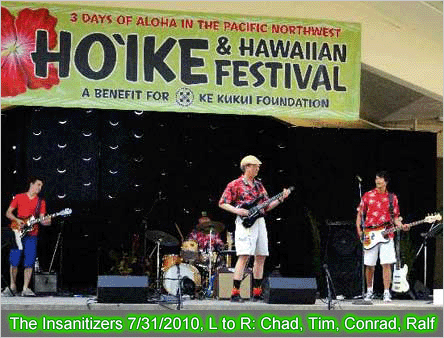
A bassist friend said that I play bass guitar like a guitarist. This
is probably because I play lots of 16th notes and note sequences that
resemble lead guitar more than traditional bass riffs. I record with
a 33-inch medium scale bass guitar. The two inch difference from standard
length bass makes it much easier to play quickly.
Whimsical Surf is about art as well as music, and I’ve
received many enthusiastic comments about the three paintings. The
front cover and the disc use a painting I bought from artist D.R.
Mullins of Bristol, Tennessee in 1998; he played bass guitar and I
suppose the painting is biographical. The painting is large and hangs
in my living room. The rear cover and the image under the disc use
a painting by Sally Sherwood of Portland, Oregon. I was lucky to find
it in an art exhibit there earlier this year. My wife Cynthia painted
the picture of my surf guitar playing conjuring up rolling surf and
fantastic creatures. It hangs in my music studio.
These recordings are used by the Insanitizers performing band for
their parts. It has been straightforward and efficient for the band
members to start learning a song from parts that work well. They can
change their parts, but a reference that works well has been established.
With me in the performing group are Ralf Palin on bass, Tim Ennis
on drums, and Chad Van Dyke on guitar. They are excellent musicians
with terrific positive attitudes and deep personal sincerity. It is
a great pleasure to associate and perform with them.
Favorite
Guitars
My feelings
fluctuate, but I always like and trust my Steinberger USA GM guitar
with built-in bass and treble boost/cut circuits. It stays in tune,
the action is low, nothing ever needs adjusting on its bridge or composite
material neck, the vibrato is smooth, it’s not heavy, and its
humbuckers sound superb clean or dirty. It also has 3 single coils
but I find them thin and shrill.
Another favorite is a Switch brand guitar made of an undisclosed dense
hard plastic, with 3 pickups. It had two severe flaws that took about
5 minutes and $2 to fix: it wouldn’t stay in tune and it had
the sustain of a mandolin, i.e., none. With a screwdriver I adjusted
the vibrato to float; then it stayed in tune even with extreme whammies.
With a few cents worth of epoxy I glued stacks of washers and quarters
onto the vibrato arm block, and later I added some lead rod I bought
from a fisherman’s store. These weights added wonderful sustain
and note stability. Its stock single coil ceramic pickups sound sweet
and surfy; I replaced the middle pickup with a humbucker for versatility.
This guitar now has the same physical virtues as the Steinberger.
It’s too bad Switch went out of business; the flaws I fixed may
have contributed to this.

For recording I often use a Washburn Idol WI-64 guitar with a Bigsby
I added. I replaced the bridge pickup with a double lipstick pickup.
The action is mediocre but the double single-coil tone is superb for
recording, chimey with depth. Another favorite is a guitar I radically
surgerized. It started as a budget Kramer with excellent vibrato but
weak everything else. I replaced pickups and saddles, epoxied weights
onto the vibrato arm block, dressed the frets, and thinned the neck
in half lengthwise using a rotary hand tool. Luckily I didn’t
hit the truss rod. I installed four pickups including a long lipstick,
with an 11-position rotary selector knob to engage any one or two
pickups at a time.
My showiest guitar is a Goya Rangemaster full hollow body I bought
new in 1965. It had the same mandolin-like sustainlessness as the
Switch guitar, and I fixed it in the same way; now it sings with sustain.
Its single-coil pickups have an unusual raucous growling twang.
Some of my guitars sound best with flatwounds, others with half-rounds,
and some with regular wound strings. Differences among these three
are enormous. Matching string type with guitar was trial-and-error,
but the results were clear. The only flatwound set I’ve found
with enough treble for my music is D’Addario ECG23. For regular
wound strings I prefer a 9-46 set, but some of my guitars need a 50
or larger low E string to prevent buzzing or keep the string on the
fretboard.
Pedal-wise I use digital multi-effects boxes by Line 6, Yamaha, and
Roland for recording, and by DigiTech and Zoom for performing. I use
an original Japanese Ibanez Tube King for sizzling or thick overdrive;
I was lucky to buy one during their limited availability. For recording
I use the effects that come with Sonar Producer.
I usually perform with a Traynor YCV20 tube amp, an equalizer pedal
for finer tone control, and a multi-effects box for reverb, delay,
and occasional phaser. This setup goes from saccharine clean to edgy
to smoky harmonic distortion and anywhere in between.
Musical
Influences
Classical
music came first chronologically in my life. It is the basis of my
awareness of all music. The straight-ahead feel of ‘60s rock
and surf-rock music resembles early and middle classical music, such
as Bach, Beethoven and Brahms. I guess this is why I quickly developed
a liking for rock-n-roll in the 1960’s. When I was young I listened
to classical music to saturation. Now I hardly hear most of it because
of over familiarity. The same goes for the recordings of the Ventures
and the Shadows. Buying the Ventures’ LPs as they came out in
the ‘60s and ‘70s was as basic to my life as eating meals.
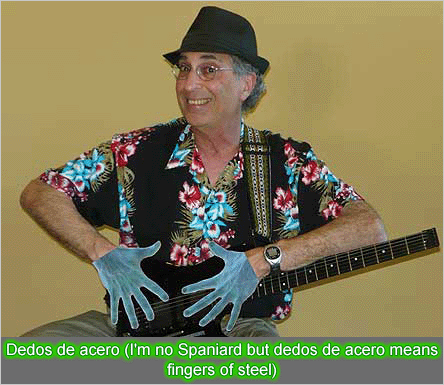
I have listened to the recordings of many recent surf-rock groups.
For the past several years my favorite albums are Mission to Mir
(2001) and Scandinavian Interlude (2004) by the Beat Tornados,
an obscure foursome from Norway. They are fun, they have a good beat,
and I like the recording mix—percussion is clearly present but
does not dominate. I used to listen endlessly to Wishbone Ash’s
all instrumental Nouveau Calls until I noticed that ninety
percent of the sound was percussion and the lead guitar track had
the lowest volume. Now I avoid such mixes. Another favorite is Moving
Target by Jon and the Nightriders; its sound is gorgeous. Get
Bach! self-released by the Baronics is a fun combination of classical
music and surf-rock. Their version of Vivaldi’s “Summer”
is the only waltz time energetic surf-rock I can point to.
For vocals I like witty lyrics, so Weird Al, Green Day, and The Polkaholics.
My Polkaholics friend Don Hedeker is encouraging me to sing. I have
been writing song lyrics. He’s a dangerous musical influence
because I might start singing them. I did post one vocal on Jango,
in sympathy with our soldiers overseas, “The Sandbagged Bagdad
Blues.” Its guitar track is very peculiar but fits perfectly,
with a sardonic play on “Caissons…Rolling.”
Upcoming
Plans
I am
half a dozen original recordings into another instrumental CD. These
recordings sound and feel different from each other, from the Whimsical
Surf CD, and from everything else. Still, I will wait for sales
of Whimsical Surf to develop before producing another CD. The
Insanitizers band has been performing in the Portland, Oregon area,
including the annual Hawaiian festival. We are on the lookout for
more gigs in Oregon and Washington State. I toured parts of Asia and
Scandinavia as a professor, lecturing to enthusiastic audiences, and
I’d be delighted to tour there with the band.
Web Site

The Whimsical Surf CD is available at:
www.CDBaby.com/cd/insanitizers
and www.guitar9.com/whimsicalsurf.html
Our website is www.MySpace.com/SurfInsanitizers
Some free MP3 downloads are available at www.last.fm/music/Insanitizers
You can find my videos on YouTube.com by searching on VentureShadow.
You can contact me at: 12E@bigfoot.com



 Released
in time for Summer 2010, The Insanitizers have a rave up on Whimsical
Surf. The 17 cut all instrumental CD is just the ticket to get
things moving in this summer heat. Interestingly, all the tracks were
written and/or arranged by Insanitizers guitarist Conrad Swartz,
who really cuts loose with a blockade of power chords and roaring
surf-rock licks while getting some rocking support from Tim Ennis
and Mike Martin (percussion) and Ralf Palin (bass).
In addition to a love of The Ventures and Dick Dale, Conrad and company
also like to surf out on vintage classical melodies from classicists
like Tchaikovsky, Rossini and Grieg while also sporting some interesting
influences like Alfred Hitchcock’s theme song! All done surf-style,
Whimsical Surf is pretty authentic from start to finish. The
CD sounds great and the band has done a super job packaging their
silver disc CD with excellent digi-pak graphics. Check The Insanitizers
out on CDBaby.com and Guitar9.com and Facebook!
Released
in time for Summer 2010, The Insanitizers have a rave up on Whimsical
Surf. The 17 cut all instrumental CD is just the ticket to get
things moving in this summer heat. Interestingly, all the tracks were
written and/or arranged by Insanitizers guitarist Conrad Swartz,
who really cuts loose with a blockade of power chords and roaring
surf-rock licks while getting some rocking support from Tim Ennis
and Mike Martin (percussion) and Ralf Palin (bass).
In addition to a love of The Ventures and Dick Dale, Conrad and company
also like to surf out on vintage classical melodies from classicists
like Tchaikovsky, Rossini and Grieg while also sporting some interesting
influences like Alfred Hitchcock’s theme song! All done surf-style,
Whimsical Surf is pretty authentic from start to finish. The
CD sounds great and the band has done a super job packaging their
silver disc CD with excellent digi-pak graphics. Check The Insanitizers
out on CDBaby.com and Guitar9.com and Facebook! My
mom insisted on piano lessons when I was young. Playing our piano
was like running in sand. It had been a motorized player piano, but
the automation was removed. Striking notes took fingers of steel and
that’s what I developed. Later, in junior high typing class,
classmates would gather to watch me type a hundred words per minute
on our manual typewriters.
My
mom insisted on piano lessons when I was young. Playing our piano
was like running in sand. It had been a motorized player piano, but
the automation was removed. Striking notes took fingers of steel and
that’s what I developed. Later, in junior high typing class,
classmates would gather to watch me type a hundred words per minute
on our manual typewriters. 

 Another
song that uses guitar effects as sound effects is “Undertow.”
Applying a phaser effect to the guitar chord riff shuttling between
B and A chords and then between A and G chords produces a giant vacuuming
sound. This doesn’t slow the pace at all, and this song barrels
along with numerous double string glissandos that span 16 frets. There
are none of the ordinary—even mundane—single string 12 fret
surf glissandos here.
Another
song that uses guitar effects as sound effects is “Undertow.”
Applying a phaser effect to the guitar chord riff shuttling between
B and A chords and then between A and G chords produces a giant vacuuming
sound. This doesn’t slow the pace at all, and this song barrels
along with numerous double string glissandos that span 16 frets. There
are none of the ordinary—even mundane—single string 12 fret
surf glissandos here.


